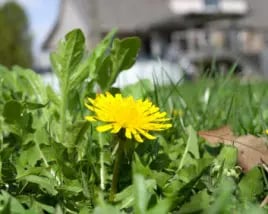Do-it-Yourself Weed Control

The colorful wild plants you admire in nature can become invasive weeds if their seeds end up in your lawn. Weed removal is tricky. If you don’t remove the plant by its roots, it will grow again. Luckily, there are some tricks for weed prevention and removal using do-it-yourself techniques. Read on to learn about the most common weeds in Pennsylvania and how to prevent or safely kill them with a few common household items.
- Dandelion
- Clover
- Crabgrass
- Plantain
- Ground Ivy
- Wild Violets
- Oxalis
- Chickweed
Weed Control
Dandelions: Dandelion seeds thrive in the heat. Higher lawns are stronger and have less heat, so adjust your mower to a higher setting in order to choke out dandelions.
Clover: Choke out clover by preventing it from taking root. This is accomplished through overseeding and aeration in addition to regular lawn care.
Crabgrass: Keep crabgrass from taking root by maintaining a healthy lawn. A healthy lawn requires aeration, seeding, fertilization, and regular and watering and cutting.
Ground Ivy: The roots of ground ivy spread underground throughout lawns. Because of this, it usually requires professional removal.
Wild Violets: Spreading can be prevented by using different tools in your garden and lawn. Be sure to uproot young wild violet plants right after watering the soil.
Oxalis: Thick grass chokes out oxalis roots, so keep your lawn healthy to prevent an invasion. Avoid overwatering, as well.
Plantain: Aerate your lawn to help loosen the soil and allow your grass to grow deep, healthy roots, leaving fewer open spaces for plantain to take root.
Chickweed: Prevent chickweed by maintaining a healthy lawn and reducing its soil compaction.
DIY Weed Killer
- Mix 1-qt white vinegar with 4-oz lemon juice and 2-oz dish soap in a spray bottle. Dish soap suffocates the weed while the vinegar and lemon juice penetrate the weeds.
- Spray the mixture onto the leaves of the weeds. Avoid windy days or use a piece of cardboard to protect nearby plants as you spray to avoid killing flowers and other desired growth.
- Inspect the weeds to ensure that they have begun to turn brown. If not, carefully spray again.
- Conduct another inspection of the sprayed weeds after 14 days and respray where there is new growth. After another 14 days, spray a third time if weeds have reappeared. All the treated weeds should be dead after a third spray, with the exception of crabgrass and other weeds with deep rhizomes.
- Spread table or rock salt at the base of crabgrass or other hardy weeds and spray one more time with the vinegar mixture. Salt can kill other plants, so keep the salt confined to the roots of the weeds.
- After the weeds have been killed, dissipate the salt by watering the treated area thoroughly.
Contact us: For further assistance in your battle against weeds, call Green Lawn Fertilizing at 855-469-0692. We’re here to help you achieve a beautiful yard. Call us today for more tips and tricks to keep your lawn weed-free.